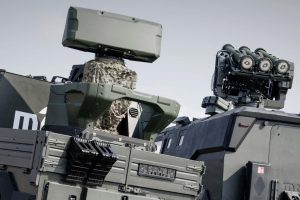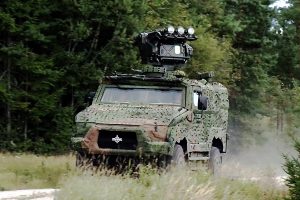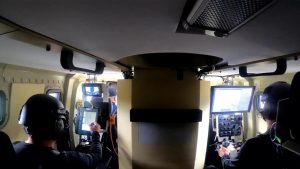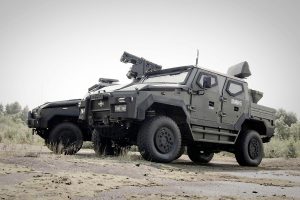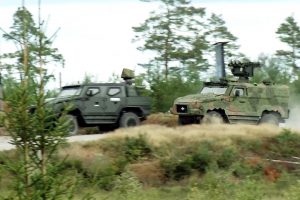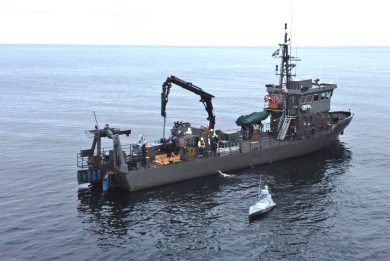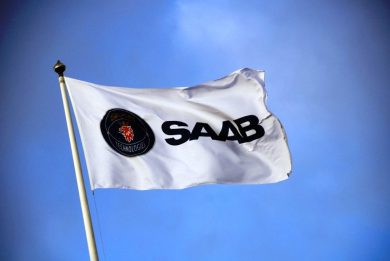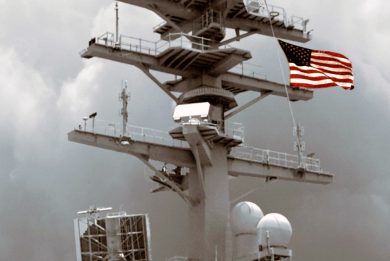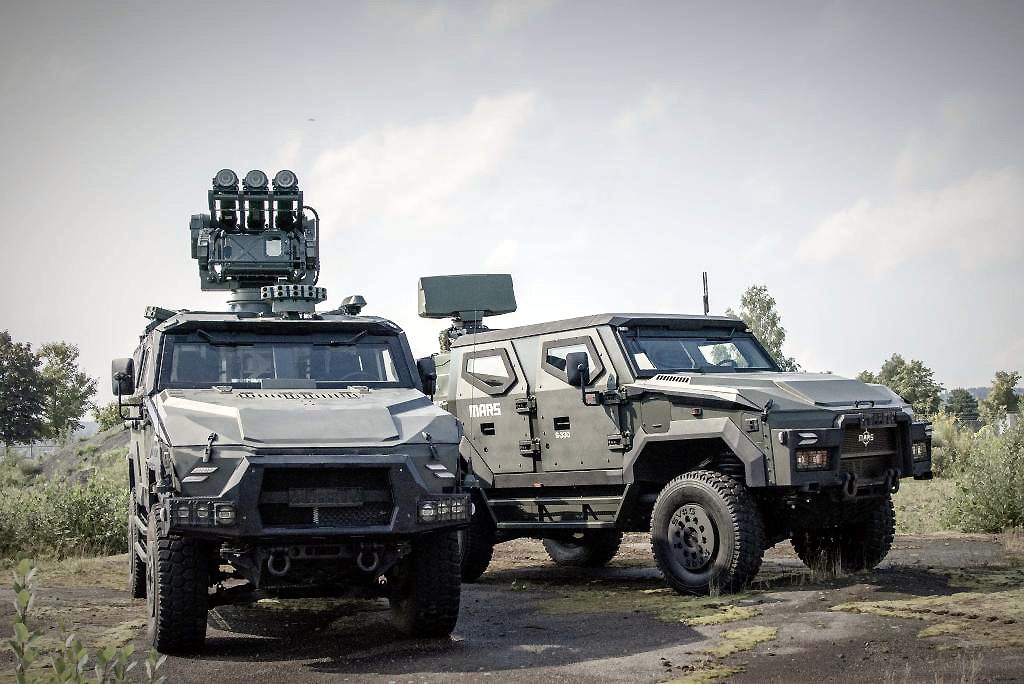
Saab: the MSHORAD goes live!
On August 30th Saab organised a demonstration of its recently unveiled MSHORAD (Medium Short Range Air Defence) system at the Karlskoga firing range. Fifteen delegations from all continents took part in the event, that saw live firings of five RBS 70 NG missiles against different targets and in various tactical situations.
This event was anticipated by EDR On-Line in a previous article written after the Ground Combat Demonstration 2022 that took place in early May, in which the MSHORAD system was extensively depicted. In that event the Mobile Firing Unit (MFU) was on display, and EDR On-Line was fully briefed on that vehicle-mounted system. We will therefore focus this article mostly on the add-on information provided on the Mobile Radar Unit (MRU) and on trials.
A well as the MFU, the MRU is based on the same mobility platform coming from the Czech Republic: manufactured by SVOS, the MARS 4×4 S-330 is a 12.5-14 tonnes GVW vehicle fitted with adjustable suspensions and a STANAG Level 2 armour, available with full length cabin, which is used for the MFU, and in the pick-up variant, used for the MRU. The Giraffe 1X X-band 3D radar is packed in the so-called Compact Radar Module that is installed on the vehicle’s flatbed, the whole unit including the AESA antenna, the power distribution unit and the signal data processing unit. A battery pack is fitted that ensures 8 hours autonomy in silent watch; these are reloaded when the engine runs, while Saab foresees an increase in the silent watch time considering the evolution in battery technology.
The standard crew is made of three personnel, one driver and two operators, these manning one console each, however according to the company a single operator can do the job. The operators are installed on the back seats, to which they access via the two rear-side doors; a ruggedised laptop is installed in front of each operator, a light and easily integrated solution. During the deployment the radar is lowered, while in operation a telescopic mast allows to raise it above the vehicle’s rooftop level. According to Saab the mast is stable enough to allow operating the radar on the move, at slow speed. With a refresh rate of 1 second, 3 to 6 seconds are enough to transform a plot into a track, which can be evaluated and prioritised thanks to the C2 system decision support algorithms. A beam-riding missile, the RBS 70 does not require lock-on-before-launch and has the advantage of being unjammable, as no chaffs or flares can deviate its course luring its seeker, hence one missile ensures a very high kill probability, maximising the destructive capability of a single MFU; a beam riding weapon not being a fire-and-forget, its drawback is that the operator must remain static to guide it on the designated target, increasing its potential vulnerability.
While the radar can operate on the move, the same is true for the MFU, which can track the assigned target while moving, the missile being fired as soon as the vehicle stops to allow the operator keeping the laser beam, generated by the Common Sight Module (CSM), on target with utmost accuracy. As in the MRU, also in the MFU the two operators, commander and gunner, are installed on rear seats, the commander being equipped with a laptop-based working station similar to that used in the MRU while the gunner mans the remotely controlled weapon station and the sighting system. A fire-on-the-move solution can be developed, according to Saab, however for the time being no potential customer has shown interest in investing on this option.
Designed to deal with fixed- and rotary-wing aircraft as well as against cruise missiles, thanks to the multirole capacity of the Giraffe 1X radar Saab’s MSHORAD can be used also against UAS, the sensor being capable to detect and classify small, unmanned air systems, RAM (Rocket, Artillery, Mortar) targets being also visible by the radar. The CSM electro-optic sighting system installed on the MFU ensures positive identification and fine-tune tracking, as well as missile guidance. It also allows to use missiles against surface targets, such as small boats or armoured personnel carriers, should the need arise.
Testing scenarios
As said during the demonstration held at the Bofors Firing Range in Karlskoga five RBS 70 NG were fired, and all of them destroyed the assigned target. The mission assigned to the 2nd MSHORAD notional air defence platoon, which fielded 4 MFUs and 1 MRU (in real only one MFU was deployed), was to protect and preserve friendly activity, limit enemies’ freedom of movement, obstruct opponents’ activities, and stop enemy from conducting activities. The platoon was part of the 14th Mechanised Brigade that was on the move from Karlskoga to Stockholm.
The first scenario saw two different types of targets, the first a small UAV and the second an armed helicopter in hovering. The platoon was defending a mechanised battalion against air threats and its sensors identified a DJI Matrice 300 RTK quadcopter commercial drone which 2.7 kg payload make its apt to carry a lethal package. A small size drone, 670x430x810 mm, the quadcopter was picked up by the Giraffe 1X before being handed over to the optronic system that tracked it until a missile was launched against the target which was moving at 15 m/s (54 km/h), destroying it at 2,000 meters distance. The combat helicopter, represented by an AS365 N3 fuselage installed on a mast 10 meters over the ground to simulate a hovering aircraft, popped up instants after the drone was destroyed; here too the MFU was able to fire a second RBS 70 NG in a very short time, in fact range safety measures imposed a longer interval compared to reality. From the shooters position the target dimensions were 1.9×2.35 meters, the helicopter being blown off at 1,908 meters distance.
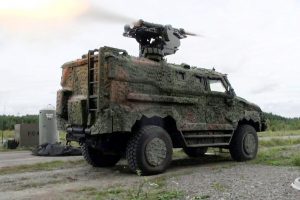
The two following engagements were carried out not from the MFU but from a MANPADS, to demonstrate the MSHORAD flexibility; a tripod carried in the MFU can be deployed, and fitted with the CSM and a missile, however during the demonstration a MANPADS was already deployed, camouflaged under a Saab Barracuda Camosphere. These shootings were carried out against the typical air defence target, an 8 meters long towed sleeve, with a 950 mm diameter, which was towed at 90 m/s (324 km/h), and simulated an aircraft carrying out a CAS (Close Air Support) mission. The first target was neutralised at 3,506 meters distance, while the second was hit at 3,841 meters. When used in the MANPADS configuration, that allows for example to deploy the system on a roof in an urban context, the link to the C2 can be done in two ways; one is connecting by cable the tripod launcher to the MFU exploiting its communication system, as it was the case during tests, or to fit it with a comms suite, which allows it to get the data directly from the MRU via the Combat Net Radio.
The shootings described above were all carried out in daytime. The last one, which was done from the MFU, was carried out at night. In fact the thermal imager included in the optronic sight was used also during day firings, but at night it was key in fine-tracking the sleeve which temperature differed from that of the background quite enough to ensure full visibility from the cooled thermal camera. The target was the same of shootings #3 and #4, the sleeve being intercepted at 3,481 meters distance.
A flexible system looking further ahead
While the MARS 4×4 S-330 was selected as development platform, the MSHORAD is platform agnostic, a 500 kg payload capacity being required for the MFU while 400 kg are sufficient for the MRU. With drones becoming more and more an issue on the battlefield, Saab is considering expanding MSHORAD effectors, adding for example high energy weapons, such as laser or high power microwave systems, that would complement missiles, avoiding using expensive rounds that might often be an overkill compared to the actual target. Energy storage might however prove to be an issue for the time being. EDR On-Line understood that Saab is not working directly on such systems, but it’s studying their application and would work partners for answering future requirements. Further effectors envisaged fall in the Electronic Warfare domain, here being definitely a major player in this field. In the future a further evolution of the RBS 70, the more recent one being the NG, might surface, no comments being made on it except that it will be backward compatible as all the evolutions of the Saab missile.
Photos courtesy Saab

